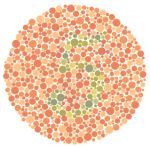 This is a classic example of a test that is often used to see if someone has red/green colour blindness or more accurately colour deficiency. As colour deficiency is reported to affect approximately 8% of the male population, it is one of the most common barriers to accessing digital information.
This is a classic example of a test that is often used to see if someone has red/green colour blindness or more accurately colour deficiency. As colour deficiency is reported to affect approximately 8% of the male population, it is one of the most common barriers to accessing digital information.
Barriers that people with colour deficiency may encounter can include:
- colour that is used as a unique marker to emphasise text on a web site
- text with inadequate colour contrast levels when seen against particular background colours or patterns, so that it become unclear.
- web pages that are coded in a way that does not allow the user to change the look and feel via a browser setting or add-on / extension. .
The W3C in their comments on how people with disabilities use the web state that: “to use the Web, some people with colour blindness use their own style sheets to override the font and background colour choices of the author”. W3C guidelines recommend a minimum contrast levels between text and background and that colour should not be the only means of conveying meaning.
Fox Valley College Colour Guide for Web design page provides some examples of how some colour combinations can affect those with colour deficiencies, as well as links to resources that simulate and check colour choices. Colour is frequently used with science teaching and the Institute of Physics has produced a best practice guide for teachers on Supporting Students in STEM with Colour Vision Deficiency (2017).
